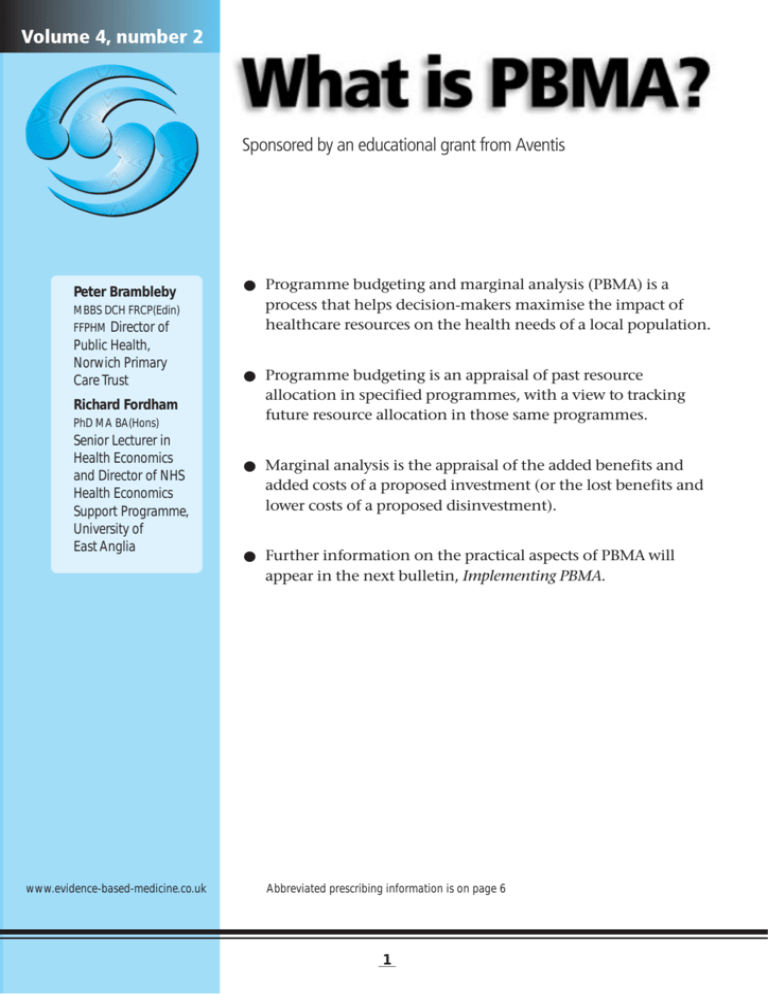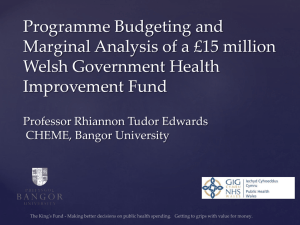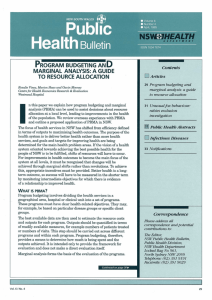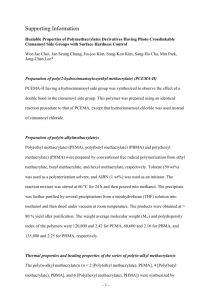
Volume 4, number 2
Sponsored by an educational grant from Aventis
Peter Brambleby
MBBS DCH FRCP(Edin)
FFPHM Director of
Public Health,
Norwich Primary
Care Trust
Richard Fordham
PhD MA BA(Hons)
Senior Lecturer in
Health Economics
and Director of NHS
Health Economics
Support Programme,
University of
East Anglia
● Programme budgeting and marginal analysis (PBMA) is a
process that helps decision-makers maximise the impact of
healthcare resources on the health needs of a local population.
● Programme budgeting is an appraisal of past resource
allocation in specified programmes, with a view to tracking
future resource allocation in those same programmes.
● Marginal analysis is the appraisal of the added benefits and
added costs of a proposed investment (or the lost benefits and
lower costs of a proposed disinvestment).
● Further information on the practical aspects of PBMA will
appear in the next bulletin, Implementing PBMA.
www.evidence-based-medicine.co.uk
Abbreviated prescribing information is on page 6
1
What is
PBMA?
What is PBMA?
Programme budgeting is a
retrospective appraisal of
resource allocation, broken down
into meaningful programmes,
with a view to tracking future
resource allocation in those
same programmes.1
Marginal analysis is the
appraisal of added benefits and
added costs when new investment
is proposed (or lost benefits and
lower costs when disinvestment is
proposed), in an incremental way.1
PBMA can assist decision-makers in
directing resources, with the aim of
maximising the impact of healthcare on
the health needs of the local population.
The approach relies on two fundamental
economic principles: opportunity cost, or the
forgone benefits of the next best alternative
use of a given set of resources, and marginal
analysis, which examines the incremental
costs and benefits of shifting resources from
one area to another, to provide insight into
whether changes should be made. One of the
primary goals of priority setting is therefore
to maximise the benefits and minimise the
opportunity costs for a given set of resources.
PBMA helps us to be:
● Comprehensive and inclusive
● Systematic and consistent
● Collaborative and fair
● Patient-focused and evidence-based
● Open and accountable.
PBMA should be:
● Relatively quick and simple, but sufficiently
robust to be credible and inform decisions
● Supported by a common contract currency
and resource mapping methodology
● Backed up by regular dialogue between
clinicians, managers and the public.
The origins of PBMA
PBMA had its roots in the Rand Corporation
in the USA in the 1950s. Its first major
application was not in healthcare, but for
2
the US Department of Defense in the 1960s
where it was a cost-accounting tool that
could display, over time, the deployment of
resources towards specific military objectives,
such as wars overseas, the support of NATO or
the defence of the homeland, instead of the
conventional budgetary headings of tanks,
missiles or diesel fuel. Allocation of new
resources, or shifts between budgets, could be
judged on their relative contribution to these
main objectives – a much more meaningful
way of making decisions.
This can equally be applied to healthcare.
Instead of seeing investment on the level of
a hospital or drug budget, the focus switches
to specific health objectives such as reducing
death rates from heart disease, improving
indicators of child health, reducing the
burden on family carers of patients with
senile dementia, and so on. The ultimate aim
is to maximise health gain by deploying the
available resources to best effect.
One of the principal researchers in this
field, responsible for bridging the gap between
military and healthcare applications in the
USA, was Alain Enthoven, later an important
influence on NHS reforms in the UK.2
It is not just the programmes – couched in
terms of target groups or particular outcome
indicators – that are important here, but the
notion of the ‘margin’. A marginal analysis is
necessary because as each extra unit of input
is added, the outcome usually increases in a
roughly linear fashion to start with, before
levelling out. This characteristic (the so-called
‘law of diminishing returns’) is apparent
whether one is launching an additional
missile to destroy a military target or
deploying an additional health visitor
to improve an immunisation uptake rate.
As a programme expands its output, the
incremental benefit to the recipients of each
additional ‘unit’ of output tends to decline.
Imagine if we offered hip replacement to
anyone with the slightest pain in the hip – the
level of improvement, and the ratio of risk to
benefit, would be much more favourable in
those at the severe end of the spectrum of
symptoms than in those at the milder end.
What is
PBMA?
PBMA in the NHS
Programme budgeting can help NHS health
economies to understand:
● Where they currently invest resources
● The effectiveness of those investments
● The most effective way of investing in
services in the future.
The implementation of PBMA at local
level is supported by the modernisation and
cost-effectiveness objectives set out in all
recent NHS publications and review articles
(see Box 1).2–6
The National Programme Budget Project
was set up in 2002 by the Department
of Health7 to see if it is possible to map
expenditure by major disease groups and
national service frameworks (NSFs) across the
whole NHS, including primary, community
and hospital care.
An understanding of how resources are
invested will:
● Enable commissioners to identify current
patterns of service delivery for groups
of patients and to identify variations
between providers and access to service
by geographical area
● Facilitate the mapping of care pathways
● Be a powerful tool for agreeing the desired
patterns of commissioning
● Make it possible to monitor NHS
expenditure against the NSFs
● Help identify different expenditure
patterns across the country, explain these
to the population at large and get a more
meaningful engagement of the public
in the determination of future patterns
of spending.
Implementing PBMA
Box 1. What does the NHS say about PBMA?
‘Efficient use of resources will be critical to delivering the best for
patients. It is important that managers and clinicians alike have a proper
understanding of the costs of local services, so that they can make
appropriate local decisions on the best use of resources.’
Department of Health. The new NHS: Modern, Dependable. London:
DoH, 1997.3
‘Partnerships between secondary and primary care clinicians and with
social services will provide the necessary basis for the establishment
of "programmes of care", which will allow planning and resource
management across organisational boundaries.’
Department of Health. The new NHS: Modern, Dependable. London:
DoH, 1997.3
‘The core content [of the Health Improvement Programme] will be …
resource mapping, sharing base-line information and forecasts …
it will be important that strategies are based wherever possible on
sound evidence of the clinical cost-effectiveness and appropriateness
of interventions.’
Department of Health. Health improvement programmes: planning for
better health and better health care. HSC 1998/167.4
‘Effective purchasers need programme budgeting and marginal analysis …’
Enthoven A. In pursuit of an improving National Health Service. London:
Nuffield Trust, 1999.2
‘The development of National Service Frameworks for important
diseases/conditions such as cancer and coronary heart disease provides
impetus to identify expenditure in these programmes and others.’
Department of Health. Programme Budgeting. London: DoH, 2002.5
‘There has been widespread diffusion of PBMA in [regional health
authorities] internationally and, overall, the impact of this approach has
been positive.’
Mitton C, Donaldson D. Twenty-five years of programme budgeting and
marginal analysis in the health sector, 1974–1999. J Health Serv Res Policy
2001; 6: 239–248.6
3
An eight-step plan for PBMA is shown in
Box 2 (page 5). This plan will be examined
and illustrated in greater detail in the next
bulletin, Implementing PBMA.
Applied PBMA
Medicine development is forever presenting
new and challenging budgetary dilemmas.
Typically, a new drug (for example, as
recommended by the National Institute for
Clinical Excellence [NICE]) will cost more than
the currently available therapy, but will bring
additional benefits to patients. As a result of
adopting the new drug, further savings may
occur that fall beyond the drug budget. The
important figure is therefore not the simple
‘acquisition cost’ but the net cost, after
delivery mechanisms, laboratory monitoring
and savings from not using the original
therapy have been factored in. Similarly, in
respect of health gain it is net health gain that
matters, after all positive and adverse effects
have been considered. These net shifts in cost
and outcome are of primary importance to
decision-makers pursuing efficiency.
This is where local economic evaluation
comes in. Although a national evaluation
may have already been conducted, a more
specific evaluation may often be required to
establish the local impact. National norms of
cost and outcome may not apply at local level,
especially at the margin. The starting point
What is
PBMA?
in terms of historical spending patterns may
be different between different parts of the
country, so the trade-offs will be different.
New money is not always available for
every potentially beneficial treatment. PBMA
can assist in those instances where ‘resource
neutrality’, or at least a degree of trade-off, is
a requirement – that is to say, new investment
has to come from a reallocation of existing
(and usually less beneficial) resources.
Imagine that the chief pharmacist of a
large district general hospital has noticed an
increasing trend in adverse events following
surgery or prolonged hospital stay, due to
venous thromboembolic disease (VTED). This
has led to more bed-days in general medicine
and medicine for the elderly. The current
pattern of preventive and curative therapy is
patchy, with different drugs being prescribed
by different clinicians. In addition to
this being potentially less than optimally
effective care (taking into account recent
developments in VTED therapy) there is
an element of confusion for junior doctors,
leading to possible medical error. The chief
pharmacist, with support from the clinical
governance committee in the hospital and
the published evidence base, decides to
recommend standardising on exonaparin,
even though he recognises that this would
add to the hospital drug budget.
As an initial step, an analysis is conducted
of the current VTED drug expenditure
patterns by specialty. It is found that 80% of
the total spend comes from four specialties:
Box 2. PBMA in eight steps
1. Choose a set of meaningful
programmes.
2. Identify current activity and expenditure
in those programmes.
3. Think of improvements.
4. Weigh up incremental costs and
incremental benefits and prioritise a list.
5. Consult widely.
6. Decide on changes.
7. Effect the changes.
8. Evaluate progress.
4
orthopaedics, general surgery, geriatrics and
general medicine. The remaining 20% comes
from other areas of the hospital – the coronary
care unit, the intensive care unit and the
gynaecology department. Hospital activity
analysis shows that over the last five years there
has been an upward trend in the number of
cases of deep vein thrombosis and pulmonary
embolism, with a concomitant increased
expenditure on their treatment. It is agreed
that attention will focus on the 80% of drug
use accounted for by the four main specialties.
On presenting his findings and ideas to the
chief executive, it is made clear to the chief
pharmacist that the drug budget can only be
increased if the changes are fully self-funded
and ‘resource-neutral’ to the hospital overall.
From his computer-based prescribing
system, the chief pharmacist estimates that a
switch to the new VTED therapy will roughly
cost the hospital an additional £100,000. This
takes account of an increased use in VTED
prophylaxis in orthopaedics, general surgery
and long-term medical patients. Subsequent
savings are likely to be made in the treatment
of symptomatic patients.
The chief pharmacist obtains the cost map
from the finance department and decides
to investigate possible areas of saving (an
example cost map is given in Table 1).8 He
constructs a model to look at the reduction
in VTED and the savings in the medical
specialties which would otherwise deal with
these cases. While not on a sufficient scale
to allow actual closure of beds (‘fixed costs’),
these reductions would at least generate
savings on variable elements of a patient
hospital episode and permit ‘virement’
(transfer between budgets) from medicine to
surgery budgets to cover the prescribing costs.
The chief pharmacist presents his plans
at the next chief executive’s meeting, where
the additional investment requirement is
discussed. The proposals are found to fit in
with clinical governance policies on reducing
hospital complication rates, shortening stays
and implementing NSF ‘clinical best practice’
recommendations for older patients. GPs
from the nearby primary care trusts are also
supportive, because they recognise the savings
in primary care if VTEDs can be prevented.
In this scenario, the new rationalisation policy
is approved.
What is
PBMA?
Table 1. An example of a cost map (figures in £000s)8
Spend area
Age group in years (as in weighted capitation formula)
0–4
General surgery
5–14
15–44
45–64
65–74
75–84
1,682.6
1,733.1
2,088.8
719.1
85+
All ages
% of total
740.8
7,554.7
10.57
269.8
1,931.3
2.70
1,227.7
7,730.6
10.82
78.6
116.5
1,114.5
3.4
17.7
140
310.3
471
Orthopaedics
73.8
209.2
903.7
941.5
1,147.7
Ear, nose and
throat surgery
118.2
403.3
363.8
165.5
86.2
92.1
28.4
1,257.5
1.76
Ophthalmology
45.7
32.8
59.4
173.2
372.6
588.9
285.5
1,558.1
2.18
Oral surgery
99.3
181
168.6
8.2
7
4.4
1.4
469.9
0.66
36.6
46.8
17.8
22.8
7.6
131.6
0.18
0
0
0
3,277.1
4.58
67.7
3,350.8
4.69
274.8
1,970.3
2.76
Urology
3,227
Pain relief
0
0
Obstetrics
0
1.1
3,272.1
3.9
Gynaecology
0.8
7.5
1,899.6
846.4
335.6
193.2
149.3
88.4
408.5
270.9
296.4
482
1,994.5
2,693.2
640.8
63.3
6,288.9
8.80
0
357
0.50
A&E
General medicine
1.8
0
895.3
Haematology
0
0
50
126.6
34.8
145.6
Rheumatology
0
0
92.6
177.8
66.8
19.4
7.8
364.4
0.51
Geriatrics
0
0
0
93.9
505.2
5,170.5
4,037.2
9,806.8
13.72
0
0
3,619.8
5.06
Paediatrics
2,728.7
843.5
47.6
0
Psychiatry
24.2
56.1
1,815.6
1,180
790.9
1,347.6
453.9
5,668.3
7.93
228.8
138.5
660.7
1,069.4
745.7
312.3
130.8
3,286.2
4.60
Learning difficulty
0
42.9
280.7
150.5
17.8
1.4
0
493.3
0.69
Health promotion
6.1
11.5
38.5
23.3
13.8
9.8
3.3
106.3
0.15
Drug abuse
0
9.2
227.1
12.6
3.4
0
0
252.3
0.35
HIV/AIDS
0
20.8
166.6
20.8
0
0
0
208.2
0.29
Disablement
2.7
7.7
63.2
34.7
42.4
118.8
45.1
314.6
0.44
Joint finance
23.6
44.7
149.8
90.6
53.8
38.1
12.8
413.4
0.58
Community nursing
9.4
18.7
148.6
281.4
1,012.4
696.5
Community clinics
0.6
1.1
9
16.6
28.9
62.2
43.4
161.8
0.23
Community therapy
43.9
39.5
77.1
83.3
127.7
189.3
99
659.8
0.92
GP pathology
33.2
33.9
220
114.9
106.2
165.2
72.8
746.2
1.04
GP radiology
15.9
16.2
219.4
55.2
51
69.8
35
462.5
0.65
Hospice
0
0
129.3
78.4
46.5
32.8
11
298
0.42
Out of district
0
0
124.5
75.3
44.8
0
0
244.6
0.34
118
989.8
560
264.3
258
51.2
2,602.2
3.64
Regional specialties
482
0
2,649
3.71
Extra contract cases
360.9
Ambulance
132.6
88.2
568.3
294.5
273.6
369.1
184.9
1,911.2
2.67
76.2
144.2
482.8
292.2
173.4
122.8
41.6
1,333.2
1.87
2,692.2 15,823.3 11,276
11,033.6
17,504.2
8,893.1
71,479.9
2,788
8,506
8,578
14,225
22,516
11,866
71,408
97
186
131
78
78
75
100
Management costs
Total
4,257.7
Capitation allocation 2,931
Variance: actual/
capitation (%)
145
5
100
Volume 4, number 2
What is
Further reading
Further information on the practical aspects of PBMA will
appear in the next bulletin, Implementing PBMA.
McGuire A, Henderson J, Mooney G. The economics of
health care: An introductory text. London: Routledge, 1998.
Drummond MF, O’Brien BJ, Stoddard GL, Torrance GW.
Methods for the economic evaluation of health care
programmes, 2nd edn. Oxford: Oxford University
Press, 1997.
Mooney G, Gerard K, Donaldson C, Farrar S. Priority setting
in purchasing: some practical guidelines. Research Paper 6.
National Association of Health Authorities and Trusts
(NAHAT), Birmingham, 1992.
An entire issue of Health Policy (1995; 33) was devoted to
articles on the subject of PBMA.
Scott A, Donaldson C, Scott S. Program budgeting and
marginal analysis: pragmatism and policy. J Health Serv Res
Policy 1999; 4: 1–2.
References
1. Mooney G, Russell E, Weir R. Choices for health care: a
practical introduction to the economics of health provision,
2nd edn. London: MacMillan, 1986.
2. Enthoven A. In pursuit of an improving National Health
Service. London: Nuffield Trust, 1999.
3. Department of Health. The new NHS: Modern.
Dependable. London: DoH, 1997.
4. Department of Health. Health improvement programmes:
planning for better health and better health care. HSC 1998/167.
5. Department of Health. Programme budgeting. London:
DoH, 2002.
6. Mitton C, Donaldson C. Twenty-five years of programme
budgeting and marginal analysis in the health sector,
1974–1999. J Health Serv Res Policy 2001; 6: 239–248.
7. Department of Health. Initial meeting of the National
Programme Budget Project. London: DoH, 2002.
8. Brambleby P. A survivor’s guide to programme
budgeting. Health Policy 1995; 33: 127–145.
Prescribing information: Clexane® syringes
Presentation: Single dose pre-filled syringe containing 40mg enoxaparin in 0.4ml (4,000IU). Indications: Prophylaxis
of thromboembolic disorders of venous origin, in medical patients bedridden due to acute illness. Dosage &
Administration: Medical patients bedridden due to acute illness, the recommended dose is 40mg (4,000IU) once daily
for a minimum of 6 days until return to full ambulation, for a maximum of 14 days. Elderly: No dosage adjustment
necessary. Children: Not recommended. Contraindications: Acute bacterial endocarditis, major bleeding disorders,
thrombocytopenia in patients with positive in-vitro aggregation test in presence of Clexane®, active gastric/duodenal
ulcer, hypersensitivity to enoxaparin, stroke (unless due to systemic emboli) and other patients with increased risk
of haemorrhage. Warnings and Precautions: Clexane® must not be administered by the intramuscular route.
Haemodynamically unstable patients with pulmonary embolism may require alternative treatment. Not recommended
for use in patients with prosthetic heart valves. Clexane® should be used with care in hepatic insufficiency, history of
thrombocytopenia, and conditions with increased bleeding potential. Different low molecular weight heparins may not
be equivalent; alternative products should not be substituted during therapy. Heparins can suppress adrenal secretion
of aldosterone leading to hyperkalaemia. Pregnancy: Clexane® should not be used during pregnancy unless no safer
alternative is found. Lactation: Advise avoidance of breast-feeding. Interactions: Care in patients receiving agents
affecting haemostasis, e.g. oral anticoagulants, thrombolytics, systemic glucocorticoids, NSAIDs, aspirin. Adverse
Reactions: Bleeding in the presence of associated risk factors, rarely retroperitoneal and intracranial bleeding. Rarely
thrombocytopenia, liver abnormalities (eg transaminases and alkaline phosphatase changes), allergic reactions. At site of
injection: pain, haematoma, irritation, rarely hard inflammatory nodules and skin necrosis. Osteoporosis has not been
reported with Clexane® but the risk cannot be excluded. Heparins can cause increase in plasma potassium, and rarely,
clinically significant hyperkalaemia. Rare reports of intra-spinal haematoma when using spinal/epidural anaesthesia and
post-operative indwelling catheter. Pharmaceutical Precautions: Do not mix with other injections or infusions.
Do not store above 25°C. Do not refrigerate or freezer.
Legal Category: POM PL 0012/0196. Basic NHS cost for 10 pre-filled syringes 40 mg: - £45.16
Full Prescribing Information and further information is available on request from Aventis Pharma, 50 Kings Hill Avenue,
West Malling, Kent. ME19 4AH.
Prepared: April 2003. ®denotes a Registered Trade Mark.
PBMA?
This publication, along with
the others in the series, is
available on the internet at
www.evidence-based-medicine.co.uk
The data, opinions and statements
appearing in the article(s) herein
are those of the contributor(s)
concerned. Accordingly, the
sponsor and publisher, and their
respective employees, officers
and agents, accept no liability
for the consequences of any such
inaccurate or misleading data,
opinion or statement.
Any enquiries please contact:
Team Assistant to the Health
Economics Unit
Aventis House
Kings Hill
West Malling
Kent
ME19 4AH
Tel: 01732 584000
Fax: 01732 584080
Published by Hayward Medical
Communications, a division of
Hayward Group plc.
‘What is ...’ is a Hayward
Group plc publication.
Sponsored by an educational grant from
Aventis
HE0230503
Date of preparation: June 2003
6
Copyright © 2003 Hayward
Group plc.
All rights reserved.
What is… ?
Sponsored by an educational grant from Aventis
’What is…?’ bulletins
faxback form fax no. 01732 584080
If you would like to receive more information about the
What is… ? series simply print out this form, fill in your
details and fax it to: Team Assistant to the Health
Economics Unit, Aventis.
Name: ____________________________________________________________________________
Position: ____________________________________________________________________________
Address: ____________________________________________________________________________
____________________________________________________________________________
____________________________________________________________________________
Postcode: _______________________________ (For mailing purposes a postcode must be supplied)
Tel: _______________________________ Fax: ________________________________________
Email: ____________________________________________________________________________
www.evidence-based-medicine.co.uk







